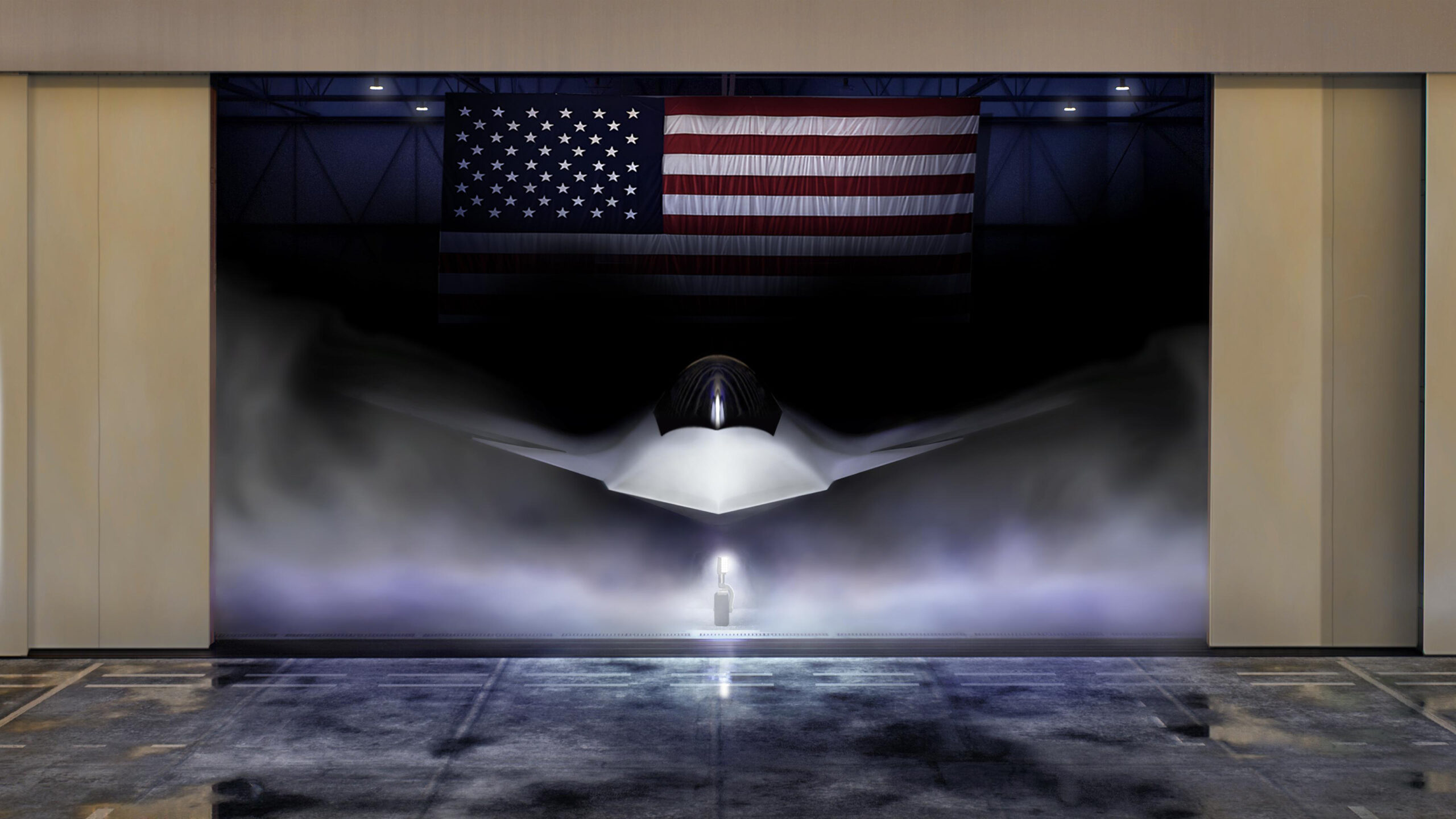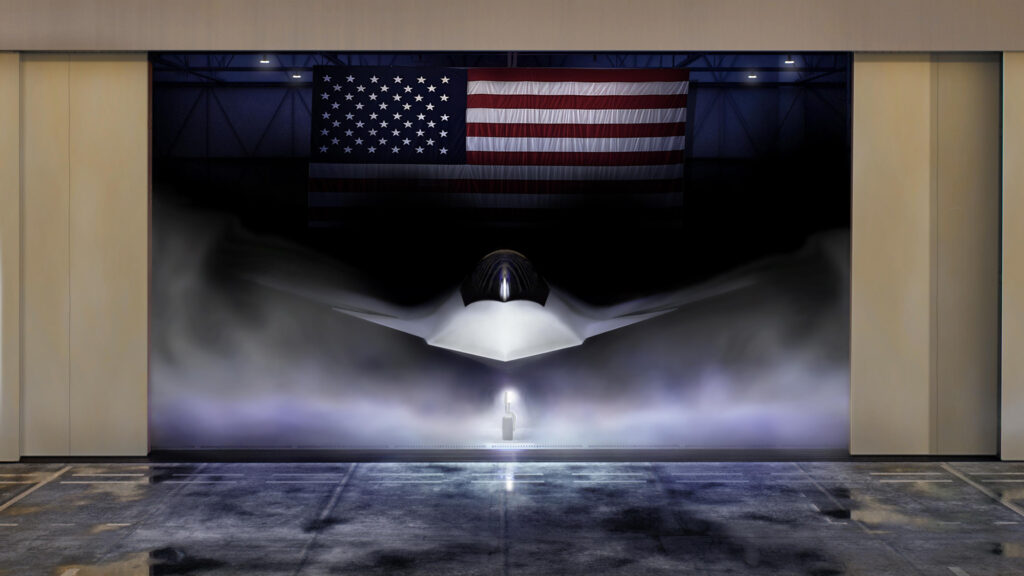
Shown is a graphical artist rendering of the Next Generation Air Dominance (NGAD) Platform. The rendering highlights the Air Force’s sixth generation fighter, the F-47. The NGAD Platform will bring lethal, next-generation technologies to ensure air superiority for the Joint Force in any conflict. (U.S. Air Force graphic)
WASHINGTON — Boeing has won an Air Force contract to develop the first ever sixth-generation fighter, dubbed the F-47, which is seen as critical to maintaining America’s air supremacy over China, President Donald Trump announced today.
The aerospace giant’s victory in the Air Force’s Next Generation Air Dominance (NGAD) program is a game-changer for Boeing, whose defense business has suffered billions of dollars in losses in recent years stemming from a series of ill-performing fixed-price contracts. In particular, the win gives Boeing the opportunity to build a new fighter jet at a time when its F/A-18 line is nearing closure, a major lifeline for the company’s St. Louis facility.
Boeing bested Lockheed Martin in the NGAD competition, ending Lockheed’s status as the sole prime contractor producing stealth fighters in the West — namely the F-22 Raptor and F-35 Joint Strike Fighter. A third competitor, Northrop Grumman, dropped out of the competition in 2023 but is expected to compete for a new Navy fighter jet.
In the decade since the existence of the program was revealed, little has come to light about the highly-secretive NGAD fighter, which is expected to enter service in the 2030s and replace the F-22.
Sources confirmed the Boeing win to Breaking Defense minutes before Trump announced the contract decision in a briefing at the White House, flanked by Defense Secretary Pete Hegseth, Air Force Chief of Staff Gen. David Allvin and Lt. Gen. Dale White, the service’s top uniformed acquisition officer.
Positioned alongside them was a rendering of the F-47 partially enveloped in shadow, with only the front half of the aircraft visible. Trump asserted that the name of the plane — likely a reference to Trump’s presidency — had been selected by “the generals.”
“The F-47 is equipped with state of the art stealth technologies – virtually unseeable – and unprecedented power, the most power of any jet of its kind ever made. Maneuverability, likewise, there’s never been anything like it, despite the power and speed,” Trump said.
“America’s enemies will never see it coming,” he said. “Hopefully we won’t have to use it for that purpose, but you have to have it. And if it ever happens, they won’t know what the hell hit them.”
Trump declined to disclose the value of the contract, stating that doing so would give away too much technology or the size of the fighter, which he described as “a good-sized plane.”
However, he hinted for the first time ever that the United States will consider selling “toned down” versions of the F-47 to “certain” allies — a break from how the F-47’s predecessor, the F-22, was barred from exports. (Trump also noted “We like to tone them down by about 10 percent, which probably makes sense, because someday maybe they’re not our allies.”)
NGAD X-planes have been flying since 2020, “flying hundreds of hours, testing cutting-edge concepts, and proving that we can push the envelope of technology with confidence,” Allvin said in a written statement. For that reason, the first F-47 produced during the engineering and manufacturing development (EMD) phase of the contract will fly during Trump’s presidency, he added.
The Air Force stated that the contract announcement was made following “a fair and thorough source selection process” that reaffirmed the NGAD concept “as the most capable and cost-effective solution to maintain air superiority” in a complex global threat environment.
Steve Parker, interim CEO of Boeing’s defense unit, said the company recognizes the importance of designing, building and delivering a sixth-gen fighter for the Air Force.
“In preparation for this mission, we made the most significant investment in the history of our defense business, and we are ready to provide the most advanced and innovative NGAD aircraft needed to support the mission,” he said.
Lockheed said it remained committed to advancing the state of the art in air dominance technologies.
“While disappointed with this outcome, we are confident we delivered a competitive solution. We will await further discussions with the U.S. Air Force,” the company said in a statement.
Roman Schweizer, an analyst with TD Cowen, noted that the Air Force planned to spend about $19 billion on the NGAD program over the next five years, but that those funding levels could change with the release of the fiscal 2026 budget. The program is expected to cost “hundreds of billions of dollars,” he said.
A Circuitous Route to Contract Award
Unlike the Joint Strike Fighter competition, which played out publicly between Boeing and Lockheed in a series of flight demonstrations, the NGAD competition has taken place largely behind closed doors, aside from the Air Force’s disclosure in 2020 that at least one NGAD demonstrator had flown.
Dubbed a “sixth-generation” system, officials say the jet will have cutting-edge stealth, communications and weapons capabilities. The fighter will additionally be expected to operate with the service’s forthcoming fleet of drone wingmen known as Collaborative Combat Aircraft (CCA), something both Trump and Allvin noted in their White House comments. General Atomics Aeronautical Systems and Anduril are competing for the separate CCA contract.
Despite expectations previously laid out by the Air Force, the formal contract award for the NGAD platform failed to come to pass last year amid questions relating to its design and projected price tag. Following the results of the November election, former Air Force Secretary Frank Kendall then decided to punt the decision on the platform to the Trump administration.
An internal Air Force review in December subsequently validated the jet’s requirements, Breaking Defense previously reported, potentially strengthening the decision by the Trump administration to ultimately award the stealth fighter’s contract.
In the time since, China has unveiled purported sixth-generation platforms, and Air Force officials have become more vocal about the need for NGAD if air superiority is going to be achieved.
“Bluntly, what this study told us is, we tried a whole bunch of different options, and there was no more viable option than NGAD to achieve air superiority in this highly contested environment,” Maj. Gen. Joseph Kunkel, the Air Force’s director of force design, integration and wargaming said during a March 4 panel discussion at the AFA Warfare Symposium.
During the announcement today, Hegseth criticized the Biden administration’s decision to review the program.
“President Trump said we’re reviving it, and we’re doing it,” he said. “Under the previous administration, we looked like fools. Not anymore.”
Several lawmakers who have advocated for the continuation of the NGAD program hailed the contract decision.
“Today’s announcement is a momentous day both for St. Louis and the country as the production of next generation fighter jets will be in the Show Me State,” said Sen. Eric Schmitt, a Missouri Republican and member of the Senate Armed Services Committee. “This has been a key priority for me since I arrived in the Senate, and I’ve been a fierce advocate not only to keep the program but for Boeing to be the one to build it.”
SASC Chairman Roger Wicker, R-Miss., called the F-47 “a vital platform that would allow the United States to rule the skies for years to come,” while his counterpart in the house, Rep. Mike Rogers, R-Ala., called the decision “welcomed news.”
Arizona Sen. Mark Kelly, the top Democrat on SASC’s tactical air and land committee, said awarding the NGAD contract was the “right decision to avoid costly delays and move forward with our next generation fighter.”
Billions On The Line
Winning NGAD isn’t just a point of pride for Boeing — it will serve as a foundational part of the company’s business going forward.
Barring any major revisions by the Trump administration, the NGAD fighter’s per unit price is thought to be in the hundreds of millions of dollars. Former Air Force Secretary Frank Kendall previously described the fighter as costing “multiples” of the F-35 and shared plans that the service was then aiming for an initial buy of 200 NGAD fighters, though that number could change.
But that’s just part of the spending. Air Force budget documents say the service plans to invest billions of dollars between fiscal years 2025 and 2029 to develop the NGAD fighter, with more funds planned beyond to finish development and proceed with production. When the Air Force announced in May 2023 the goal of awarding the NGAD contract in 2024, the service said the winning vendor would enter at the engineering and manufacturing development phase.
The Air Force is also spending billions to develop a new engine for the fighter, which uses “adaptive” turbofan technologies that can adjust how air flows through the powerplant in flight, altering what’s known as its bypass ratio. The technology promises improved performance for features like thrust and fuel efficiency. Pratt & Whitney and GE Aerospace are facing off under that separate engine development effort known as Next Generation Adaptive Propulsion, which recently saw its budget ceiling raised in a new round of contracts to both vendors.
Meanwhile, the Navy is forging ahead with its own next-gen fighter that will replace the venerable F/A-18 and E/A-18 for the service’s own air superiority missions. That contest is now down to Boeing and Northrop after Lockheed was knocked out of the running, Breaking Defense previously reported. Lockheed’s loss in the Air Force’s NGAD competition now leaves the world’s largest defense contractor locked out of foreseeable sixth-generation aircraft efforts — and comes at a time when the F-35 is under new scrutiny by historic allies wary of the new Trump administration.
It’s not clear whether the Air Force might pursue Kendall’s suggestions of aggressive cost savings for the stealth jet, especially as budgetary constraints may no longer be much of a factor. While Kendall indicated that some sacrifices, like reducing the complexity of the fighter’s engine, might be necessary to make the jet viable, a surge in defense spending championed by Republicans on Capitol Hill may obviate the need for such tradeoffs. It’s also notable the award comes prior to the Senate confirmation of Troy Meink, who President Donald Trump has tapped to serve as Kendall’s successor.
According to Kendall, the F-35 program has been instructive for the Air Force, namely for what the NGAD program should not do. Specifically, Kendall — a longtime critic of the F-35, who accused the program of exhibiting “acquisition malpractice” years ago in a previous DoD role — said in May 2023 that the government will acquire requisite intellectual property and data rights, as well as ensure the jet has a modular open systems architecture.
Failing to take the same steps on the F-35, Kendall said, was a “serious mistake” that officials have long complained allowed Lockheed too much control over the Joint Strike Fighter enterprise and fostered conditions for disappointing readiness rates.
“We’ll have a much tighter degree of government control over the future of [NGAD] than we’ve had,” Kendall said.
Updated 3/21/25 at 2:14pm with comments from Boeing and Lockheed.








